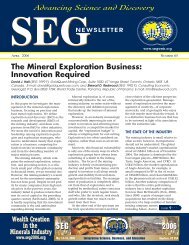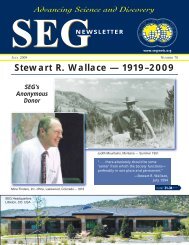SEG 45 Final_qx4 - Society of Economic Geologists
SEG 45 Final_qx4 - Society of Economic Geologists
SEG 45 Final_qx4 - Society of Economic Geologists
You also want an ePaper? Increase the reach of your titles
YUMPU automatically turns print PDFs into web optimized ePapers that Google loves.
EXPLORATION REVIEWS<br />
42 <strong>SEG</strong> NEWSLETTER No 63 • OCTOBER 2005<br />
... from 41<br />
Exploration Reviews (Continued)<br />
Rosemont, Peach Elgin, and Broadtop<br />
Butte deposits. The aggregate resource<br />
is estimated at 5 billion pounds <strong>of</strong> copper,<br />
with molybdenum credits. Augusta<br />
is commissioning a drilling program<br />
and a prefeasibility study to define<br />
near-surface oxide and deeper sulfide<br />
reserves.<br />
CALIFORNIA<br />
Although the headline read “Gold Mine<br />
becomes Copper Mine” it was not referring<br />
to the Las Vegas gold show where<br />
your favorite property is being pushed<br />
as a uranium opportunity this year,<br />
when it was diamond play last year<br />
and gold target the year before. In this<br />
case, Sutter Gold Mining had $10,000<br />
worth <strong>of</strong> copper cable ripped <strong>of</strong>f (literally)<br />
from its Sutter Creek property.<br />
The perpetrators apparently went<br />
underground and removed the copper<br />
cable, giving a whole new meaning to<br />
underground copper mining.<br />
NEVADA<br />
White Knight Resources must be given<br />
an award for its effort to obtain free<br />
consulting. They have launched the<br />
Lower Plate Challenge. Anyone can go<br />
to their website and make an estimate<br />
<strong>of</strong> where the Lower Plate will be<br />
encountered during drilling at any one<br />
<strong>of</strong> the White Knight properties. Firstplace<br />
prize is a weekend in Las Vegas<br />
and $1,000 cash. Two questions: is the<br />
second place prize two weekends, and<br />
does the Lower Plate refer to the Roberts<br />
Mountains fault or the last dirty dish in<br />
the sink?<br />
Royal Standard Minerals<br />
announced the start <strong>of</strong> mining at<br />
Goldwedge (Nye County) with an initial<br />
bulk sample <strong>of</strong> 3,000 to 5,000 tons.<br />
A facility was built at the site to capture<br />
coarse gold, with the finer gold to be<br />
recovered by heap leaching.<br />
Gold Summit continues to drill at<br />
Monte Cristo (Nye County), but several<br />
recent holes failed to find extensions <strong>of</strong><br />
mineralization to the northeast, southwest,<br />
and other places along the “controlling<br />
fault structure.” Drilling is continuing,<br />
but the focus has turned to<br />
in-filling the resource. At least one analyst<br />
(now there is a good source) estimates<br />
that the deposit has potential for<br />
a small high-grade reserve containing<br />
0.5 to 1.0 Moz gold.<br />
Agnico-Eagle completed three holes<br />
at NDT Ventures’ Trend property in<br />
Eureka County. The holes encountered<br />
a “strongly altered and potentially mineralized<br />
system” between 1,800 and<br />
2,140 ft deep. Alteration consists <strong>of</strong> silica<br />
“flooding,” clay, and pyrite with up<br />
to 74 ppb Au. That sounds like a thousand<br />
other places in the Great Basin.<br />
Three drills are now working at<br />
Midway Gold Corp’s Spring Valley<br />
property (Pershing County). Results continue<br />
to be “all over the map.”<br />
Mineralized intervals vary from a few<br />
feet up to about 100 ft with grades in<br />
the low to mid-0.0X opt Au range, with<br />
the occasional quarter- to as much as<br />
one-half ounce <strong>of</strong> gold per ton.<br />
Castleworth Ventures’ 24 RC holes<br />
in the Black Stallion area <strong>of</strong> the Pan<br />
project (White Pine County) show<br />
promise for outlining another gold<br />
deposit. Some <strong>of</strong> the more significant<br />
intercepts include 40 ft <strong>of</strong> 0.101 opt Au,<br />
85 ft <strong>of</strong> 0.036 opt Au, and 90 ft <strong>of</strong> 0.039<br />
opt Au, all starting at, or near, the surface.<br />
The rest <strong>of</strong> the holes encountered<br />
intervals from 5 to 220 ft with grades in<br />
the 0.01–0.03 opt Au range, containing<br />
narrower intervals <strong>of</strong> higher grades.<br />
Black Stallion is 1,000–2,000 ft west <strong>of</strong><br />
the Pan fault, which hosts the Pan<br />
deposit. Mineralization seems to be<br />
along a north-south structure that is<br />
traceable for at least two miles.<br />
Idaho General Mines filed a Plan <strong>of</strong><br />
Operations with the BLM to place the<br />
Mt. Hope molybdenum project (Eureka<br />
County) into production. Idaho General<br />
claims that there are at least 1.3 billion<br />
pounds <strong>of</strong> recoverable molybdenum at<br />
Mt. Hope. Now all they need is $400<br />
million to develop the deposit, the<br />
molybdenum market stay robust, and<br />
Phelps Dodge not to return Climax to<br />
production.<br />
Canyon Resources terminated its<br />
option to acquire the Hycr<strong>of</strong>t property<br />
(Humboldt County) from Vista Gold<br />
Corp. Canyon completed 33 drill holes<br />
totaling 12,475 ft and produced a new<br />
resource estimate. The new measured<br />
and indicated resource at the<br />
Brimstone deposit is 52.7 million tons<br />
(Mt) with an average grade <strong>of</strong> 0.019 opt<br />
Au. Part <strong>of</strong> Canyon’s reason for terminating<br />
the option was “increased costs,<br />
as well as shortage <strong>of</strong> labor and large<br />
mining equipment.” Too bad they hadn’t<br />
taken advantage <strong>of</strong> the Nevada<br />
Exploration Futures Market in Rachel to<br />
secure the needed labor and equipment<br />
(see last issue’s comments).<br />
Two RC drill holes intersected highgrade<br />
gold at Gateway Gold’s Crusher<br />
target, about 600 ft northeast <strong>of</strong> the<br />
North Sammy pit (Elko County). One<br />
intercept is 135 ft <strong>of</strong> 0.122 opt Au and<br />
the other 25 ft <strong>of</strong> 0.818 opt Au. More<br />
drilling is in progress to define these<br />
gold-bearing zones.<br />
Quincy Energy released a news<br />
release outlining the results <strong>of</strong> a sevenhole,<br />
7,700-ft RC program at its Seven<br />
Troughs property (Pershing County).<br />
The three pages explained why a couple<br />
<strong>of</strong> deep 10-ft intervals <strong>of</strong> 0.01X opt Au<br />
represent “an interesting low-grade bulk<br />
mineable target … in extensive pyrite<br />
bearing zones.” Really?<br />
UTAH<br />
Palladon Ventures announced that it<br />
would start commercial production <strong>of</strong><br />
iron ore from the Comstock/Mountain<br />
Lion iron project (Iron County) in the<br />
fall. Magnetite concentrate will be produced<br />
and shipped to a Chinese purchaser.<br />
Lithic Resources leased the Crypto<br />
zinc property from EuroZinc Mining<br />
Corp. In 1993, Cyprus Minerals estimated<br />
that the deposit contains about 6<br />
Mt <strong>of</strong> sulfide mineralization with a<br />
grade <strong>of</strong> 8.6% Zn and an oxide resource<br />
<strong>of</strong> about 3.1 Mt with an average grade<br />
<strong>of</strong> 7% Zn.<br />
There is no decay in uranium activity<br />
in Utah. Over 6,000 claims were staked<br />
in the Plateau counties <strong>of</strong> San Juan,<br />
Emery, Grand, and Garfield since the<br />
start <strong>of</strong> the year, mostly for uranium.<br />
Constellation Copper Corp. completed<br />
13 drill holes in the newly discovered<br />
Flying Diamond copper deposit.<br />
All <strong>of</strong> the holes intersected copper mineralization<br />
averaging 83 ft thick with<br />
an average grade <strong>of</strong> 0.70% Cu. The<br />
deposit is open in all directions, except<br />
to the east-northeast where it abuts the<br />
east splay <strong>of</strong> the Lisbon Valley fault.<br />
Mineralization is primarily chalcocite,<br />
cuprite, and bornite in sandstone members<br />
<strong>of</strong> the Cretaceous Dakota and<br />
Burro Canyon Formations. Silver is present<br />
in the range <strong>of</strong> 0.6 to 82.4 ppm. 1






